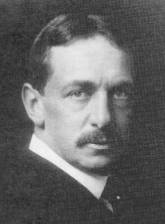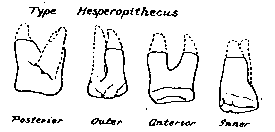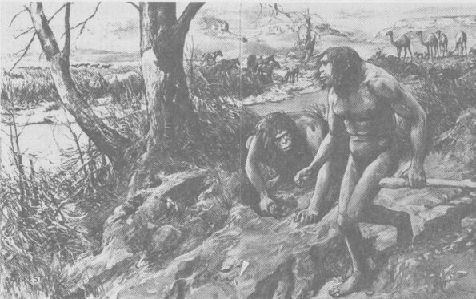
Henry Fairfield Osborn
Nebraska Man was named in 1922 from a humanlike tooth which had been found in Nebraska. As creationists tell the story, evolutionists used one tooth to build an entire species of primitive man, complete with illustrations of him and his family, before further excavations revealed the tooth to belong to a peccary, an animal similar to (and closely related to) pigs.

Henry Fairfield Osborn |
The true story is much more complex (Wolf and Mellett 1985; Gould 1991). Harold Cook, a rancher and geologist from Nebraska, had found the tooth in 1917, and in 1922 he sent it to Henry Fairfield Osborn, a paleontologist and the president of the American Museum of Natural History. Osborn identified it as an ape, and quickly published a paper identifying it as a new species, which he named Hesperopithecus haroldcookii.
 The Nebraska Man tooth, as shown in the Illustrated London News, June 24, 1922 |
The imaginative drawing of Nebraska Man to which creationists invariably refer was the work of an illustrator collaborating with the scientist Grafton Elliot Smith, and was done for a British popular magazine, not for a scientific publication. Few if any other scientists claimed Nebraska Man was a human ancestor. A few, including Osborn and his colleagues, identified it only as an advanced primate of some kind. Osborn, in fact, specifically avoided making any extravagant claims about Hesperopithecus being an ape-man or human ancestor:
"I have not stated that Hesperopithecus was either an Ape-man or in the direct line of human ancestry, because I consider it quite possible that we may discover anthropoid apes (Simiidae) with teeth closely imitating those of man (Hominidae), ..."Most other scientists were skeptical even of the more modest claim that the Hesperopithecus tooth belonged to a primate. It is simply not true that Nebraska Man was widely accepted as an ape-man, or even as an ape, by scientists, and its effect upon the scientific thinking of the time was negligible. For example, in his two-volume book Human Origins published during what was supposedly the heyday of Nebraska Man (1924), George MacCurdy dismissed Nebraska Man in a single footnote:"Until we secure more of the dentition, or parts of the skull or of the skeleton, we cannot be certain whether Hesperopithecus is a member of the Simiidae or of the Hominidae." (Osborn 1922)
"In 1920 [sic], Osborn described two molars from the Pliocene of Nebraska; he attributed these to an anthropoid primate to which he has given the name Hesperopithecus. The teeth are not well preserved, so that the validity of Osborn's determination has not yet been generally accepted."
Gregory confirmed this in his article which correctly identified the tooth:
The scientific world, however, was far from accepting without further evidence the validity of Professor Osborn's conclusion that the fossil tooth from Nebraska represented either a human or an anthropoid tooth. (Gregory 1927)
Identifying the tooth as belonging to a higher primate was not as foolish as it sounds. Pig and peccary cheek teeth are extremely similar to those of humans, and the specimen was worn, making identification even harder.

The infamous illustration of Nebraska Man done for the Illustrated London News by Amedee Forestier
Creationists often ridicule the Nebraska Man illustration, of two humanlike but extremely bestial creatures, done by Amedee Forestier for the Illustrated London News (Smith 1922). They rightly point out that an animal cannot be reconstructed from one tooth. But the drawing was not a reconstruction and was never intended, or claimed, to be accurate or scientific, being based more on the Java Man fossil than on the tooth. Smith emphasized (the following quote was in both the main text and below the drawing) its speculative nature:
"Mr. Forestier has made a remarkable sketch to convey some idea of the possibilities suggested by this discovery. As we know nothing of the creature's form, his reconstruction is merely the expression of an artist's brilliant imaginative genius. But if, as the peculiarities of the tooth suggest, Hesperopithecus was a primitive forerunner of Pithecanthropus, he may have been a creature such as Mr. Forestier has depicted." (Smith 1922, emphasis added)Osborn, who had named Hesperopithecus, was less impressed with Forestier's artistic efforts, and remarked that
"such a drawing or 'reconstruction' would doubtless be only a figment of the imagination of no scientific value, and undoubtedly inaccurate." (quoted in Wolf and Mellett 1985)Smith may have been the only major scientist who was enthusiastic about Nebraska Man's hominid status, but even he, in his 1927 book The Evolution of Man, was much more cautious than he had been in the ILN article. Although he stated that
"I think the balance of probability is in favour of the view that the tooth found in the Pliocene beds of Nebraska may possibly have belonged to a primitive member of the Human Family" (Smith 1927),Smith also recognized that Hesperopithecus was "questionable", and admitted that
"The suggestion that the Nebraska tooth (Hesperopithecus) may possibly indicate the existence of Mankind in Early Pliocene times is, as I have explained in the Foreword, still wholly tentative. The claim that real men were in existence in Pliocene and Miocene times must be regarded as a mere hypothesis unsupported as yet by any adequate evidence." (Smith 1927)
Creationists often claim that Nebraska Man was used as proof of evolution during the Scopes Monkey Trial in 1925, but this claim is apocryphal. No scientific evidence was presented at the trial. (Some evidence was read into the trial record, but even this did not refer to Nebraska Man.)
Nor is it true, as Ian Taylor (1995) has said, that the retraction of the original identification was not publicized and never made the headlines. Bowden (1981) similarly states that "Little publicity was given to the discovered error". In fact, The New York Times and The Times of London both announced the news (the NYT put it on the front page), and both also printed editorials about it (Wolf and Mellett 1985). Taylor's other claim, that the retraction was announced in the scientific literature in only four lines in the back pages of Nature, is almost correct (it was 16 lines) but highly deceptive, since it conceals the fact that a one and a half page article retracting the claim was printed in the prestigious journal Science (Gregory 1927). Moreover, Taylor should have known about this article, because it was referenced by the item in Nature to which he did refer.
Nebraska Man should not be considered an embarrassment to science. The scientists involved were mistaken, and somewhat incautious, but not dishonest. The whole episode was actually an excellent example of the scientific process working at its best. Given a problematic identification, scientists investigated further, found data which falsified their earlier ideas, and promptly abandoned them (a marked contrast to the creationist approach).
Gould S.J. (1991): An essay on a pig roast. In Bully for brontosaurus. (pp. 432-47). New York: W.W.Norton.
Osborn H.F. (1922): Hesperopithecus, the anthropoid primate of western Nebraska. Nature, 110:281-3.
Smith G.E. (1922): Hesperopithecus: the ape-man of the western world. Illustrated London News, 160:942-4.
Smith G.E. (1927): The evolution of man. Ed. 2. London: Oxford University Press.
Taylor I. (1995): Nebraska man goes to court. Science, Scripture and Salvation (ICR radio show), Jul 8:
Wolf J. and Mellett J.S. (1985): The role of "Nebraska man" in the creation-evolution debate. Creation/Evolution, Issue 16:31-43. (the best reference on the Nebraska Man episode)
Thanks to Chris Nedin for obtaining the hard-to-find Illustrated London News article on Nebraska Man.
Textbooks Continue to Use Nebraska Man?, by Mike Hopkins
Nebraska Man revisited, by Ian Taylor
This page is part of the Fossil Hominids FAQ at the talk.origins Archive.
Home Page |
Species |
Fossils |
Creationism |
Reading |
References
Illustrations |
What's New |
Feedback |
Search |
Links |
Fiction
http://www.talkorigins.org/faqs/homs/a_nebraska.html, 04/30/2003
Copyright © Jim Foley
|| Email me 